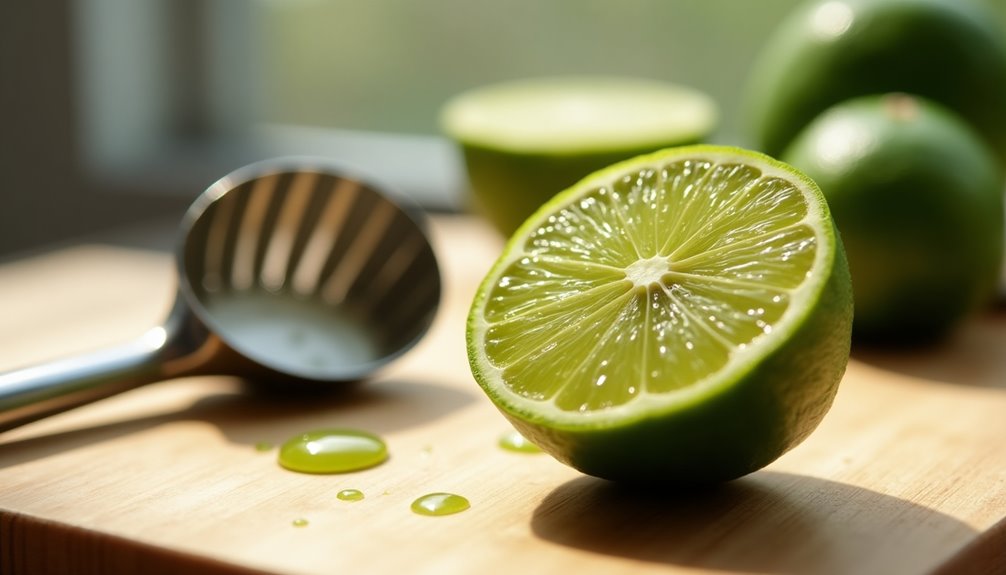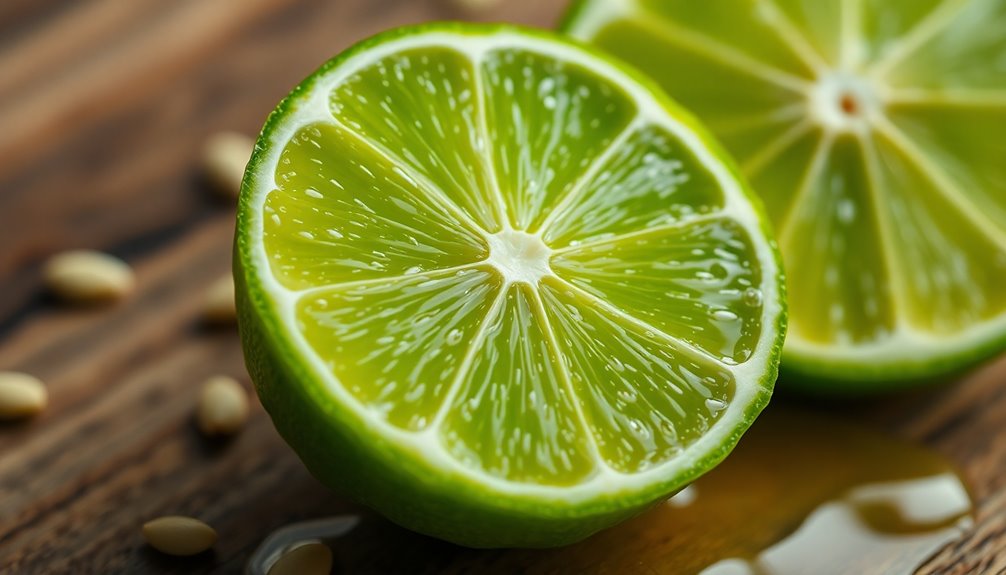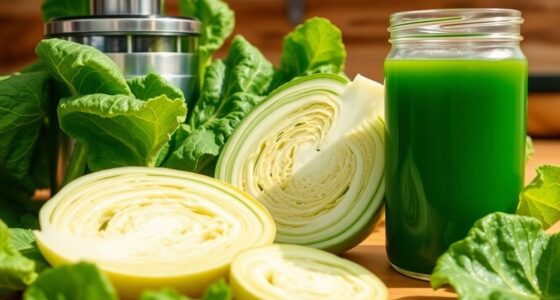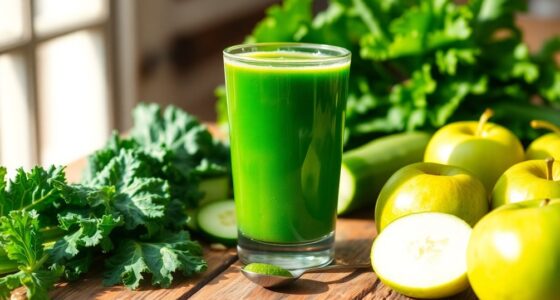A medium lime usually gives you about 2 tablespoons of juice, or 1 ounce. If you grab a larger lime, it might yield up to 3 tablespoons. For smaller recipes, just half a lime generally provides around 1 tablespoon. This knowledge helps you gauge how many limes you'll need for your cooking. Plus, there are handy techniques to maximize juice extraction. Stick around to discover more tips on getting the most juice out of your limes!
Key Takeaways
- A medium lime typically yields about 2 tablespoons (1 ounce) of juice.
- Larger limes can produce up to 3 tablespoons of juice.
- Half a lime generally gives around 1 tablespoon of juice.
- Rolling the lime before cutting can increase juice extraction.
- Freshly squeezed lime juice offers better flavor than bottled alternatives.

Have you ever wondered how much juice you can squeeze from a single lime? The answer might surprise you! On average, one medium lime yields about 2 tablespoons, or 1 ounce, of fresh juice. This can be a game-changer when you're whipping up your favorite recipes. Whether you're mixing up a refreshing cocktail or adding a zesty touch to your guacamole, knowing how much juice you're working with can help you achieve the perfect balance of flavors.
When you're in the kitchen, it's essential to understand that not all limes are created equal. The size and ripeness of the lime can affect the amount of juice it yields. Generally, a medium lime will give you that reliable 2 tablespoons, but if you're lucky enough to find a larger lime, you might squeeze out up to 3 tablespoons of juice. Conversely, a half lime typically produces about 1 tablespoon, which is perfect for those smaller recipes where you need just a splash of lime flavor.
If you've ever found yourself needing a significant amount of lime juice for a recipe, you might be wondering how many limes you'll need. For instance, if you're aiming for about 1/2 cup of lime juice, you'll need around 4 medium limes. This calculation helps ensure you don't run short while preparing your dish. Freshly squeezed lime juice is undoubtedly more vibrant and flavorful than bottled alternatives, making your culinary creations even more delightful.
There's something special about squeezing juice from fresh limes yourself. The bright taste of freshly squeezed lime juice can elevate the flavor profile of your dishes and drinks immensely. It's not just about the amount of juice; it's also about the experience of using fresh ingredients. When you squeeze the lime, you release essential oils from the zest that add an extra layer of flavor, making your recipes shine.
You might be curious about how to maximize the juice you get from one lime. One effective method is to roll the lime on a countertop before cutting it. This technique helps to break down some of the internal membranes, releasing more juice. When you finally cut it open and squeeze, you might be surprised at the extra amount of juice that comes out.
Frequently Asked Questions
Can I Substitute Bottled Lime Juice for Fresh Lime Juice?
You can substitute bottled lime juice for fresh lime juice in most recipes, but keep in mind that the flavor mightn't be as bright.
Fresh lime juice typically offers a vibrant taste that bottled versions can lack due to pasteurization and preservatives.
If you do use bottled juice, try to choose an organic option for a closer flavor match.
Always taste and adjust the amount, as acidity levels may vary.
How Many Limes to Make 1 Oz of Juice?
When you think of a lime, imagine a tiny green burst of sunshine, ready to brighten your dish.
To squeeze out 1 ounce of juice, you'll typically need just one medium lime. If your limes are smaller, grab one and a half, but if they're on the larger side, one should do the trick.
How Much Juice Does 1/2 Lemon Make?
When you squeeze 1/2 lemon, you can expect to get about 1.5 tablespoons of juice, which is roughly 0.75 fluid ounces.
If you need more juice for a recipe, keep in mind that a whole lemon yields about 3 tablespoons.
To maximize your yield, roll the lemon on the countertop before cutting it; this helps break down the membranes and releases more juice when you squeeze it.
How Many Cups Is 2 Limes Juiced?
When you juice two medium limes, you'll get about 1/4 cup of juice, which equals 4 tablespoons.
If you're planning a recipe, knowing this can help you measure your ingredients accurately.
Remember, the actual amount might vary slightly based on the size and ripeness of the limes.
If you need more juice, just multiply accordingly—four limes would give you about 1/2 cup.
Always keep that in mind when cooking!
Conclusion
In the end, squeezing that one lime is like unlocking a treasure chest of flavor. You might get about two tablespoons of juice, but it’s so much more than that. It’s the zest of summer, the spark in your dish, and the brightness in your drink. Just like that tiny fruit, your culinary creations can shine with just a little effort. So, go ahead—let the juice flow and watch your meals transform into something extraordinary. As you pour that vibrant juice into your recipe, you’ll be amazed at how a simple addition can elevate your dish from mundane to remarkable. It’s fascinating to consider how much juice from one lime can make such a difference, infusing your creations with a lively acidity that balances flavors beautifully. Embrace the bright notes that emerge, and let each squeeze inspire you to experiment further in the kitchen.
Cindy thoroughly researches juicing trends, techniques, and recipes to provide readers with practical advice and inspiration. Her writing style is accessible, engaging, and designed to make complex concepts easy to understand. Cindy’s dedication to promoting the advantages of juicing shines through her work, empowering readers to make positive changes in their lives through the simple act of juicing.











